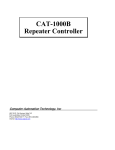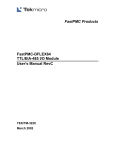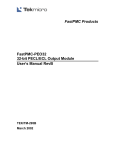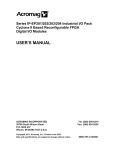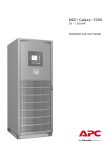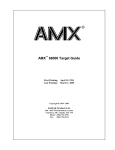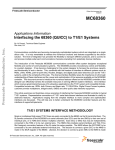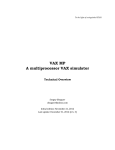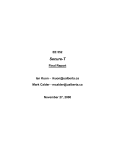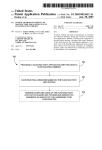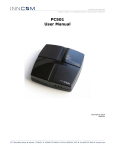Download FastPack Products FP-DFLEX-10K Customizable FLEX10K I/O
Transcript
FastPack Products FP-DFLEX-10K Customizable FLEX10K I/O Module User’s Manual TEK/TM-250B September 2001 FP-DFLEX-10K User’s Manual TEK Microsystems has made every effort to ensure that this manual is accurate and complete. However, TEK reserves the right to make changes and improvements to the products described in this manual at any time and without notice. This product is covered by a limited warranty which is described in the manual. Other than the stated limited warranty, TEK disclaims all other warranties, including the warranties of merchantability and of fitness for a particular purpose. In the event of a failure of the hardware or software described in this manual, TEK’s obligation is limited to repair or replacement of the defective item, or, if the item cannot be repaired or replaced, a refund of the purchase price for the item. TEK assumes no liability arising out of the application or use of the hardware or software, and assumes no responsibility for direct, indirect, incidental or consequential damages of any kind. The electronic equipment described in this manual generates, uses, and can radiate radio frequency energy. Operation of this equipment in a residential area is likely to cause radio interference, in which case the user, at his own expense, will be required to take whatever measures may be required to correct the interference. TEK Microsystems’ products are not authorized for use as critical components in life support devices or systems without the express written agreement of an officer of TEK Microsystems. This manual is Copyright © 1997-2001, TEK Microsystems, Incorporated. All Rights Reserved. FastPack is a trademarks of TEK Microsystems, Incorporated. IndustryPack is a registered trademark of GreenSpring Computers, Inc. Altera, MAX+Plus II and FLEX10K are trademarks of Altera Corporation. Other trademarks and registered trademarks used are owned by their respective manufacturers. Revision Information: This manual describes hardware revisions “D” and later of the FP-DFLEX-10K. For earlier hardware revisions, please refer to manual TM250A. Document ordering code and release information: URL: http://www.tekmicro.com/tm250b.pdf TEK/TM-250B Released September 2001 FP-DFLEX-10K User’s Manual Table of Contents Product Description ......................................................................................................1 Overview ................................................................................................................................... 1 Product Options......................................................................................................................... 2 Organization ..................................................................................................................3 Specifications & Support Information .........................................................................4 Performance Specifications....................................................................................................... 4 Warranty Information................................................................................................................ 5 Contact Information .................................................................................................................. 5 I/O Interface ...................................................................................................................6 I/O Pinout .................................................................................................................................. 6 Signal Configurations ............................................................................................................... 7 Signal Functions........................................................................................................................ 8 Signal Terminations ................................................................................................................ 10 IP Logic Interface ........................................................................................................12 Operating Modes..................................................................................................................... 12 Compliant FPGA Programs .................................................................................................... 13 Configuration Options............................................................................................................. 14 Download Sequence - Compliant FPGA Programs ................................................................ 16 Download Sequence - Non-Compliant FPGA Programs ........................................................ 17 ID Space - Controller .............................................................................................................. 18 I/O Space - Controller ............................................................................................................. 20 ID Register (Offset 0x00 D[7:0]) ..................................................................................... 20 Revision Register (Offset 0x01 D[7:0]) ........................................................................... 21 Initialization Control Register (Offset 0x02 D[7:0])........................................................ 21 Initialization Status Register (Offset 0x03 D[7:0]) .......................................................... 22 Initialization Data Register (Offset 0x04 D[7:0]) ............................................................ 22 I/O Space - FPGA ................................................................................................................... 23 Interrupt Space ........................................................................................................................ 23 DMA I/O Space....................................................................................................................... 23 Memory Space ........................................................................................................................ 23 Error Conditions...................................................................................................................... 23 Internal Architecture ...................................................................................................24 Overview ................................................................................................................................. 24 Clock Interface ........................................................................................................................ 26 Bus Interface ........................................................................................................................... 27 Memory Interface.................................................................................................................... 28 Initialization Interface ............................................................................................................. 28 I/O Interface ............................................................................................................................ 30 Signal Pin Assignments........................................................................................................... 31 Optional Accessories ..................................................................................................34 FP-DFLEX-10K User’s Manual Appendix A: Clock Synthesizer Programming ..........................................................35 Appendix B: Non-Standard IP Clock Frequencies ....................................................39 Appendix C: Data Sheets ............................................................................................40 FP-DFLEX-10K User’s Manual Product Description Overview The FP-FLEX family of I/O modules provides a customizable FPGA-based logic function within an IndustryPack-compatible IP module. All of the members of the FP-FLEX product family share some key features: • Downloadable FPGA programs. All members of the FP-FLEX family can be initialized over the IP bus without requiring any special programming hardware, software, or cabling. • Common I/O architecture. All members of the FP-FLEX family have a compatible I/O pinout and feature set to allow FPGA programs to be ported from one model to another. The FP-DFLEX-10K module provides a customizable ANSI/VITA 4 IP module which allows the user to develop custom logic in a small form factor. Each module supports a mix of up to 24 EIA-485 interfaces or 48 TTL interfaces, selectable under software control. The FP-DFLEX-10K is well suited for any application which requires applicationspecific logic at hardware speeds in an Industry Pack compatible package. FP-DFLEX10K modules have been used for pattern generators, pulse generators, edge detection and measurement, and various serial and parallel custom interfaces. A block diagram of the FP-DFLEX-10K is shown in the figure below. Page 1 FP-DFLEX-10K User’s Manual Product Options The FP-DFLEX-10K product family includes several different ordering options. All of the options listed below are supported, but only a subset of available options (PIO, FIO0/48 and FIO-24/0) are typically available from stock. FP-DFLEX–device–i/o PIO FIO-0/48 FIO-4/40 FIO-8/32 FIO-12/24 FIO-16/16 FIO-20/8 FIO-24/0 Programmable I/O Fixed I/O, 0 EIA-485, 48 TTL Fixed I/O, 4 EIA-485, 40 TTL Fixed I/O, 8 EIA-485, 32 TTL Fixed I/O, 12 EIA-485, 24 TTL Fixed I/O, 16 EIA-485, 16 TTL Fixed I/O, 20 EIA-485, 8 TTL Fixed I/O, 24 EIA-485, 0 TTL 10K20 EPF10K20RC240-3 [obsolete] 10K50 EPF10K50RC240-3 [obsolete] 10K70 EPF10K70RC240-3 [obsolete] 10K30A EPF10K30AQC240-3 10K50V EPF10K50VRC240-3 10K50E EPF10K50EQC240-3 10K100E EPF10K100EQC240-3 10K130E EPF10K130EQC240-3 10K200S EPF10K200SRC240-3 [alternate speed grades available by special order] Page 2 FP-DFLEX-10K User’s Manual Organization This User’s Manual is divided into the following sections: • Specifications and Warranty/Support Information. This section outlines the FP-DFLEX-10K specifications and provides information about the warranty and technical support programs. • I/O Interface. This section defines the I/O interface for the FP-DFLEX-10K. FP-DFLEX-10K models may be ordered with either the Programmable I/O (PIO) or Fixed I/O (FIO) architecture. Both architectures have compatible I/O pinouts with different I/O interface capabilities. The FPGA device program determines the functions performed by the I/O signals. • IP Logic Interface and Programming Information. This section defines the generic control and status registers that are present in all FP-DFLEX-10K models. This includes information about how to download a logic program to the FPGA device. • Internal Architecture. This section defines the internal clock and control signal architecture. This section is primarily of interest if you are developing a custom logic program for a FP-DFLEX-10K module. Each off-the-shelf FPGA program includes documentation that defines the programming interface to the FPGA and the functions of the various I/O signals. Page 3 FP-DFLEX-10K User’s Manual Specifications & Support Information Performance Specifications Clock Speed 8 or 32 MHz; wait states determined by FPGA ID Space Supported per ANSI/VITA 4-1995 specification, Format I I/O Space Byte and word accesses supported per ANSI/VITA 4-1995 specification Memory Space Byte and word accesses supported per ANSI/VITA 4-1995 specification Interrupt Capability Interrupt requests 0 and 1 supported; function determined by FPGA DMA Capability DMA request levels 0 and 1 supported; function determined by FPGA Mechanical Type I IP module per ANSI/VITA 4-1995 specification Operating Temperature 0 to 70 degrees C. Storage Temperature -40 to +85 degrees C. Page 4 FP-DFLEX-10K User’s Manual Warranty Information The FP-DFLEX-10K is warranted against defects in material or workmanship for a period of three years from the original date of purchase. If a failure occurs within the warranty period, TEK will repair or replace the product at no cost to the user. For warranty repair, please contact TEK as described below and obtain an RMA number and return shipping instructions. Contact Information If technical support or repair assistance is required, please contact TEK through one of the following methods: Internet http://www.tekmicro.com Email [email protected] Telephone +1 781 270 0808 Facsimile +1 781 270 0813 Mail TEK Microsystems, Incorporated One North Avenue Burlington, MA 01803-3313 Page 5 FP-DFLEX-10K User’s Manual I/O Interface I/O Pinout The FP-DFLEX-10K external interface consists of the signals listed below: Signal Name I/O Pin Signal Name I/O Pin A[1] 1 B[13] 26 B[1] 2 A[14] 27 A[2] 3 B[14] 28 B[2] 4 A[15] 29 A[3] 5 B[15] 30 B[3] 6 A[16] 31 A[4] 7 B[16] 32 B[4] 8 A[17] 33 A[5] 9 B[17] 34 B[5] 10 A[18] 35 A[6] 11 B[18] 36 B[6] 12 A[19] 37 A[7] 13 B[10] 38 B[7] 14 A[20] 39 A[8] 15 B[20] 40 B[8] 16 A[21] 41 A[9] 17 B[21] 42 B[9] 18 A[22] 43 A[10] 19 B[22] 44 B[10] 20 A[23] 45 A[11] 21 B[23] 46 B[11] 22 A[24] 47 A[12] 23 B[24] 48 B[12] 24 Reserved 49 A[13] 25 GND 50 The I/O Pin column shows the pin numbers on the IP I/O connector. These pin numbers typically correspond directly to the IP carrier’s external interface connector pin numbers. For example, a Motorola MVME162 VMEbus carrier maps each IP module’s 50 I/O pins to a 2x25 header connector with the same pin numbering as the IP I/O connector. Page 6 FP-DFLEX-10K User’s Manual Signal Configurations FP-DFLEX-10K modules are available with two different types of I/O functions. The first type of function, “Programmable I/O”, may be configured for single-ended or differential operation under FPGA control. The Programmable I/O functions use EIA485 transceivers but are not compatible with the full common-mode voltage range of EIA-485 due to the presence of the programmable single-ended circuitry on the I/O signals. The second type of I/O function, “Fixed I/O”, is configured at the factory for either EIA485 or TTL operation in blocks of 8 lines. The EIA-485 interfaces are completely compatible with all EIA-485 requirements, including common mode voltage range. All EIA-485 receivers have 100 Ω (nominal) termination resistors that can be dynamically connected or disconnected, under FPGA or host control. The supported ordering codes are shown below: Suffix Description -PIO Programmable I/O. Each 4 pair group of the 24 A/B pairs may be configured by the FPGA as four bidirectional differential signals or as eight bidirectional single-ended TTL signals. -FIO-0/48 Fixed I/O. No EIA-485 signals, 48 bidirectional TTL signals. -FIO-4/40 Fixed I/O. 4 bidirectional EIA-485 signals, 40 bidirectional TTL signals. -FIO-8/32 Fixed I/O. 8 bidirectional EIA-485 signals, 32 bidirectional TTL signals. -FIO-12/24 Fixed I/O. 12 bidirectional EIA-485 signals, 24 bidirectional TTL signals. -FIO-16/16 Fixed I/O. 16 bidirectional EIA-485 signals, 16 bidirectional TTL signals. -FIO-20/8 Fixed I/O. 20 bidirectional EIA-485 signals, 8 bidirectional TTL signals. -FIO-24/0 Fixed I/O. 24 bidirectional EIA-485 signals, no TTL signals. Page 7 FP-DFLEX-10K User’s Manual Signal Functions The FP-DFLEX-10K I/O signals consist of 24 external signal pairs, designated A[1:24] and B[1:24]. The I/O functions are controlled by three signals (DE, DO and RI) for each A/B signal pair and a S485 signal for each group of four A/B pairs. A block diagram of a single A/B pair is shown below: MAX1484 DE[x] A[x] EXTERNAL I/O DO[x] B[x] nS485 RI[x] TERMINATION CONTROL S485 IDT74FST3245 MAX335 Each S485 signal has a corresponding nS485 signal which must always be set as the inversion of the S485 signal. The I/O functions are implemented with the following devices: • Maxim EIA-485 Transceiver, p/n MAX1484, used for EIA-485 interfacing. • Maxim Octal SPST Switch, p/n MAX335, used for EIA-485 termination. • IDT Octal Bus Switch, p/n IDT74FST3245, used for TTL signal connections. Copies of the data sheets for the above devices are included in Appendix C. Page 8 FP-DFLEX-10K User’s Manual The I/O control logic is as follows: • If the S485 signal for a signal group [x:y] is low, the signal group is configured as eight bidirectional TTL signals. In this case, the DO[x:y] signals are connected to A[x:y], the RI[x:y] signals are connected to B[x:y], and the DE[x:y] signals should be low. The switching between A/B and DO/RI is performed using bidirectional bus switches, so the FPGA program may configure DO[x:y] and RI[x:y] as any combination of input or output signals, with output signals being either standard TTL, open drain, open source, or tristated depending on the FPGA program. • If the S485 signal for a signal group [x:y] is high, the interface provides four bidirectional differential signals with EIA-485 characteristics. In this case, the DO[x:y] signals are connected to the EIA-485 drivers, the RI[x:y] signals are connected to the EIA-485 receivers and the DE[x:y] signals enable the EIA-485 drivers. The DO[x:y] signals are outputs from the FPGA; the state of each DO[x:y] signal is only significant if the associated DE signal is high, enabling the EIA-485 driver. The RI[x:y] signals are inputs to the FPGA; the state of each RI[x:y] signal reflects the current EIA-485 input state of the associated A/B signal pair regardless of the state of DE. The six S485 signals are mapped to signal groups as follows: S485[x] Description S485[1] Controls A[1:4] and B[1:4] S485[2] Controls A[5:8] and B[5:8] S485[3] Controls A[9:12] and B[9:12] S485[4] Controls A[13:16] and B[13:16] S485[5] Controls A[17:20] and B[17:20] S485[6] Controls A[21:24] and B[21:24] Page 9 FP-DFLEX-10K User’s Manual In all configurations, the FPGA is responsible for controlling the S485[1:6] and nS485[1:6] signals. In the Programmable I/O (“PIO”) configuration, the FPGA may configure the signals as desired for the application’s I/O interface. In the Fixed I/O (“FIO”) configuration, the FPGA should always drive the S485[1:6] signals as shown in the table below. Model EIA-485 Signals TTL Signals S485[1:6] PIO Programmable Programmable Programmable FIO-0/48 None A[1:24] and B[1:24] 000000 FIO-4/40 A[1:4] and B[1:4] A[5:24] and B[5:24] 100000 FIO-8/32 A[1:8] and B[1:8] A[9:24] and B[9:24] 110000 FIO-12/24 A[1:12] and B[1:12] A[13:24] and B[13:24] 111000 FIO-16/16 A[1:16] and B[1:16] A[17:24] and B[17:24] 111100 FIO-20/8 A[1:20] and B[1:20] A[21:24] and B[21:24] 111110 FIO-24/0 A[1:24] and B[1:24] None 111111 Signal Terminations The FP-DFLEX-10K I/O signal pairs have a programmable termination resistor between each A/B pair. The termination resistor should be turned on for EIA-485 signals that are at the endpoint of the signal cabling and turned off otherwise. The termination resistors are implemented using Maxim MAX335 switches, which have an “on” resistance between 100 and 150 Ohms. The termination resistors are controlled using a three wire serial interface, consisting of TR_CLK (clock), TR_DATA (data) and TR_nCS (chip select). The termination resistor interface is directly controlled by the FPGA, making the details of the interface up to the user FPGA program. The simplest method of control is for the user FPGA program to provide three control bits in a control register and to use a software routine to download the 24-bit value to the MAX335s. If the user would like a more automated method, TEK has a macrofunction available which accepts a clock, 24bit value and a start signal and downloads the value. The termination resistors are connected to the A/B pairs in an arbitrary order to optimize trace lengths on the printed circuit board. If the termination resistors are being configured under software control, the user will need to rearrange the bit sequence as the 24 bits are downloaded to the MAX335s. The software routine shown on the following page demonstrates the download algorithm and the required bit order. If the software routine is called with a ‘value’ argument of 0x000001 the result would be to turn on the A[1] to B[1] termination resistor and turn all others off; a ‘value’ argument of 0x800000 would turn on the A[24] to B[24] termination resistor and turn all others off. Page 10 FP-DFLEX-10K User’s Manual TEK’s hardware macrofunction for configuration of the termination resistors performs the bit sequence rearrangement automatically as a part of the download function. Upon power-up, the MAX335s are guaranteed to be in the off condition. static RESULT tekfp_dflex10k_set_term (TEKFP_HANDLE fph, WORD32 value) { TEKFP_DFLEX10K_GENERIC_IOREG ioreg_fpga; static const int term_lookup[] = { 11, 12, 9, 8, 23, 21, 18, 10, 16, 3, 20, 2, 0, 1, 15, 13, 22, 7, 17, 6, 4, 14, 5, 19 }; int i; if (fph == NULL) return (FAIL); if (fph->ioptr == NULL) return (FAIL); ioreg_fpga = fph->ioptr; if (ioreg_fpga->rev.reg.w & CTLR_REV_IS_EPLD) return (FAIL); ioreg_fpga->cr1.reg.w &= ~FPGA_CR1_TR_DATA; ioreg_fpga->cr1.reg.w &= ~FPGA_CR1_TR_CLK; ioreg_fpga->cr1.reg.w &= ~FPGA_CR1_TR_nCS; for (i = 0; i < 24; i++) { if (value & (1 << term_lookup[i])) ioreg_fpga->cr1.reg.w |= FPGA_CR1_TR_DATA; else ioreg_fpga->cr1.reg.w &= ~FPGA_CR1_TR_DATA; ioreg_fpga->cr1.reg.w; ioreg_fpga->cr1.reg.w; ioreg_fpga->cr1.reg.w; ioreg_fpga->cr1.reg.w |= FPGA_CR1_TR_CLK; ioreg_fpga->cr1.reg.w; ioreg_fpga->cr1.reg.w; ioreg_fpga->cr1.reg.w; ioreg_fpga->cr1.reg.w &= ~FPGA_CR1_TR_CLK; } ioreg_fpga->cr1.reg.w &= ~FPGA_CR1_TR_DATA; ioreg_fpga->cr1.reg.w |= FPGA_CR1_TR_nCS; return (OK); } Page 11 FP-DFLEX-10K User’s Manual IP Logic Interface Operating Modes The FP-DFLEX-10K controller has four operating modes which determine the configuration state of the FPGA and whether the EPLD controller or the FPGA responds to IP bus cycles. The operating modes are: • Reset. This is the mode after power-up initialization and is usually the mode after an IP bus reset. In Reset mode, the EPLD controller has control of the IP bus and the FPGA is held in the uninitialized condition (nCONFIG asserted low). All external I/O signals are tristated. The host typically uses Reset mode to restart the FPGA and then switches to Config mode to download an FPGA program image to the FPGA. • Config. In Config mode, the EPLD controller has control of the IP bus and the FPGA is ready to accept programming information from the IP bus. The host uses Config mode to download an FPGA program image to the FPGA. When the download is completed, the FPGA will assert CONF_DONE and the EPLD controller will automatically switch to either Idle or User mode depending on the state of the Auto-User-Start configuration bit (ICR[02]). • Idle. In Idle mode, the EPLD controller has control of the IP bus and the FPGA is configured and running. Idle mode is only supported with a compliant FPGA program; the definition of a compliant FPGA is outlined below. If the FPGA is compliant, the host will typically not use the Auto-User-Start bit and allow the EPLD controller to switch to Idle mode after the FPGA program image has been downloaded. The host can then verify that CONF_DONE is asserted and that nSTATUS is not asserted, configure any desired modes in the ICR register, and then switch to User mode under host control. • User. In User mode, the EPLD controller has relinquished control of the IP bus to the FPGA and the user FPGA program is configured and running. Page 12 FP-DFLEX-10K User’s Manual The current mode determines the state of several internal signals as shown in the table below. Mode IP Bus Cycles nCONFIG CS nCS Reset All cycles under EPLD control Low; forces FPGA into initialization mode High Low Config All cycles under EPLD control High High Low Idle All cycles under EPLD control High Low CLKFAST User All cycles under FPGA control; ID cycles handled by EPLD if Disable-ID-Cycles configuration bit is low. High High CLKFAST CLKFAST: Low for 8 MHz IP clock, high for 32 MHz IP clock. Compliant FPGA Programs To be considered “compliant” for the purposes of the discussion in the manual, an FPGA program is required to: • Monitor the CS input and disable IP bus cycles and tristate all IP bus control outputs when the CS input is low. • Implement a read-only ID register at offset zero. The ID register may contain any value selected by the user. • Implement a read-only or read-write revision register at offset one. The revision register may contain any value selected by the user provided that the 0x0080 bit is not set. Most of these functions are built into TEK’s IP bus interface macrofunction; user FPGA programs which use TEK’s macrofunction for the IP bus interface are automatically compliant FPGA programs. Page 13 FP-DFLEX-10K User’s Manual Configuration Options The FP-DFLEX-10K EPLD controller has several configuration control bits which determine how the EPLD controller interacts with the FPGA and the IP bus. The control bits are designed to accommodate the widest possible range of user FPGA programs, including “legacy” designs from other applications. Through configuration options, the host can configure how the FP-DFLEX-10K handles reset conditions, whether the EPLD or FPGA responds to ID cycles, and whether to enable a “back door” to return control of the IP bus to the EPLD. All of the configuration control bits must be configured by the host before the FPDFLEX-10K enters User mode. Once the module is in User mode, the EPLD ICR register is no longer directly accessible because the FPGA has control of the IP bus. The configuration options are: • Auto-User-Start (ICR[2]). The EPLD controller automatically leaves Config mode when a rising edge on CONF_DONE is detected, which happens after the last byte of FPGA configuration information is written by the host. The mode that the EPLD controller changes to is controlled by the Auto-User-Start bit; if the bit is set, the EPLD controller will change to User mode and if the bit is cleared the EPLD controller will change to Idle mode. If the FPGA is compliant, it will monitor the CS signal and ignore IP bus cycles and tristate IP bus control signals if CS is low. A compliant FPGA is compatible with both Idle and User modes because it allows the EPLD controller, through the CS signal, to dynamically enable or disable FPGA control of the IP bus. If the FPGA is not compliant, it is not required to monitor the CS signal and may assume that it always has control of the IP bus after initialization. Because a noncompliant FPGA provides no mechanism to arbitrate control of the IP bus, the EPLD controller must transition from Config to User mode to avoid bus contention between the FPGA program and the EPLD controller. This bit should be set if the FPGA program is non-compliant. • No-Clear-FPGA (ICR[3]). If this bit is cleared, the EPLD controller enters the Reset mode after an IP bus reset. This has the side effect of asserting the FPGA nCONFIG signal which places the FPGA device into initialization mode, clearing the existing FPGA program image and tristating all I/O signals. If this bit is set, the EPLD controller enters either Idle or User mode after an IP bus reset. Typically, the host will always reinitialize all hardware and reload the FPGA program image after a system or IP bus reset. If this bit is set, the FPGA program will continue running after an IP bus reset. This is provided for applications that either need to continue operation after an IP bus reset or which need to perform a controlled shutdown under FPGA control. Page 14 FP-DFLEX-10K User’s Manual • No-Set-Idle (ICR[4]). This bit is only significant if the No-Clear-FPGA is set. If the No-Clear-FPGA bit is set and the No-Set-Idle bit is set, the EPLD controller will remain in the current mode after an IP bus reset. If the No-Clear-FPGA bit is set and the No-Set-Idle bit is cleared, the EPLD controller will enter Idle mode after an IP bus reset. This bit should be set if the FPGA program is non-compliant. • Disable-ID-Space (ICR[5]). This bit controls whether the EPLD controller or the FPGA responds to ID cycles in User mode. The EPLD controller always responds to ID cycles in non-User modes. If this bit is cleared, the EPLD controller monitors the IP bus and dynamically switches from FPGA to EPLD control of the IP bus to respond to ID cycles. This allows the FPGA program to avoid the need for supporting ID cycles, and also ensures that a consistent set of ID data is provided before and after FPGA initialization. If this bit is set, the EPLD controller ignores ID cycles in User mode. The FPGA may or may not respond to ID cycles depending on the user’s application requirements. This bit should be set if the FPGA program is non-compliant. • Disable-Back-Door (ICR[6]). This bit controls whether a write to I/O register zero with a value of 0xXX4A causes the EPLD controller to switch from User to Idle mode. This “back door” may be used to regain control from the FPGA program after entering User mode. If this bit is cleared, the EPLD controller monitors the IP bus and switches from User to Idle mode when an IP I/O write cycle is detected to address zero with D[7:0] equal to 0x4A. If this bit is set, the EPLD controller never switches from User to Idle mode, except possibly through an IP bus reset. If the user FPGA program is compliant, register zero contains a read-only ID value for the FPGA. This makes a write to register zero a “safe” back door because the host would have no reason to perform this operation. If the user FPGA program uses register zero as a read/write register or if otherwise non-compliant, this bit should be set to disable the back door function. All of the configuration bits are controlled through the ICR register. The ICR register is guaranteed to power up in the cleared state, but is not modified by an IP bus reset. The host software should set the ICR register to the desired state as a part of module initialization. Note that if the No-Clear-FPGA, No-Set-Idle and Disable-Back-Door bits are all set, there is no method to leave User mode other than powering down the FP-DFLEX-10K module. Page 15 FP-DFLEX-10K User’s Manual Download Sequence - Compliant FPGA Programs The following download sequence may be used to initialize the FP-DFLEX-10K module and download the user FPGA program when the program is compliant: 1. Start with either IP bus reset or power-up reset. Steps 2 through 4 may be deleted for power-up resets and if the host never sets the No-Clear-FPGA configuration bit. 2. Read the revision register (offset 1). If the 0x80 bit is set, the EPLD controller has control of the bus; proceed to step 5. If the 0x80 bit is not set, the FPGA has control of the bus. 3. Write the value 0x4A to the ID register (offset 0). If the Disable-Back-Door bit is cleared, this will relinquish control of the IP bus back to the EPLD controller. 4. Read the revision register (offset 1). If the 0x80 bit is set, the EPLD controller has control of the bus; proceed to the next step. If the 0x80 bit is not set, the back door is not enabled or a hardware failure has occurred; stop and report an error. 5. Set the Initialization Control Register (ICR) to zero. 6. Set the ICR[6:2] bits to the desired operating configuration. Because the FPGA is compliant, the No-Clear-FPGA bit is the only optional bit. 7. Set the ICR[1:0] bits to Config mode (01b). Be sure to maintain the desired state of ICR[7:2]. 8. Read the Initialization Status Register (ISR) and verify that nSTATUS (ISR[1]) is high. If nSTATUS is low, stop and report an error. 9. Poll the Initialization Status Register (ISR) until RDYnBSY (ISR[3]) is high. If the RDYnBSY bit is not high within 35 polls, stop and report an error. 10. Write a byte of the FPGA program image to the Initialization Data Register. 11. Repeat steps 8 through 10 until all bits have been downloaded. 12. Read the ICR and verify that the EPLD controller has entered Idle mode (ICR[1:0] equals 10b). 13. Read the ISR and verify that nSTATUS is high and CONF_DONE (ISR[2]) is high). 14. Set ICR[1:0] to User mode (11b). Be sure to maintain the desired state of ICR[7:2]. 15. Read the ID and revision registers of the FPGA and verify that the correct values are reported. Page 16 FP-DFLEX-10K User’s Manual Download Sequence - Non-Compliant FPGA Programs The following download sequence may be used to initialize the FP-DFLEX-10K module and download the user FPGA program when the FPGA program is non-compliant: 1. Start with either IP bus reset or power-up reset. With a non-compliant FPGA, there is no guaranteed method of confirming that the EPLD controller has control of the IP bus. This procedure assumes that the No-Clear-FPGA configuration bit is not set and that the EPLD controller therefore has control of the IP bus. 2. Set the Initialization Control Register (ICR) to zero. 3. Set the ICR[6:2] bits to the desired operating configuration. Because the FPGA is non-compliant, the Auto-User-Mode, No-Set-Idle, Disable-ID-Space and DisableBack-Door bits should be set. Depending on the specific features of the noncompliant FPGA program, the host may be able to leave some of these bits cleared. The No-Clear-FPGA bit is the only bit which is always optional. 4. Set the ICR[1:0] bits to Config mode (01b). Be sure to maintain the desired state of ICR[7:2]. 5. Read the Initialization Status Register (ISR) and verify that nSTATUS (ISR[1]) is high. If nSTATUS is low, report an error. 6. Poll the Initialization Status Register (ISR) until RDYnBSY (ISR[3]) is high. If the RDYnBSY bit is not high within 100 polls, report an error. 7. Write a byte of the FPGA program image to the Initialization Data Register. 8. Repeat steps 5 through 7 until all bits have been downloaded. 9. The EPLD controller should now be in User mode and the FPGA should have control of the IP bus. Perform whatever power-up checks are valid for the FPGA program. Page 17 FP-DFLEX-10K User’s Manual ID Space - Controller The FP-DFLEX-10K EPLD controller generated ID space contains the following information at the addresses shown: Address ID Data Description 0x00 0x49 Signature (ASCII “I”) 0x01 0x50 Signature (ASCII “P”) 0x02 0x41 Signature (ASCII “A”) 0x03 0x48 Signature (ASCII “H”) 0x04 0x33 Manufacturer ID (0x33 = TEK Microsystems) 0x05 0x50 Model Number (0x50 = FP-DFLEX) 0x06 0x00 Revision (0x00 for Type I cards, 0x01 for Type II rev B cards) 0x07 0x00 Reserved (set to 0x00) 0x08 0x00 Driver ID, low byte (currently 0x00) 0x09 0x00 Driver ID, high byte (currently 0x00) 0x0A 0x10 Number of bytes used (currently 16) 0x0B 0xXX CRC of ID information (bytes 0x00 through 0x0F) 0x0C Installed FPGA type (0x11 = 6016, 0x22 = 10K20, 0x25 = 10K50, 0x27 = 10K70, 0x33 = 10K30A, 0x35 = 10K50V, 0x45 = 10K50E, 0x4A = 10K100E, 0x4D = 10K130E) 0x0D Installed FPGA speed (1 = -1, 2 = -2, 3 = -3) 0x0E Installed Memory: SRAM (0x00 = none, 0x01 = 16K x 16, 0x03 = 64K x 16) 0x0F Installed I/O: 00 = PIO, Fx = FIO-N/(24-N) where x = N/4 Example: FIO-0/48 = 0xF0, FIO-24/0 = 0xF6 0x10 - 0x3F Reserved Future revisions of the FP-DFLEX-10K will have different data in the revision field and may include a non-zero driver ID. The manufacturer ID and model number will remain as shown above. Page 18 FP-DFLEX-10K User’s Manual The exact values of ID bytes 12 through 15 for each of the current FP-DFLEX-10K models is shown in the table below. Model ID Data Bytes 12 - 15 Model ID Data Bytes 12 - 15 FP-DFLEX-10K20-PIO 22 03 03 00 FP-DFLEX-10K50E-PIO 45 03 03 00 FP-DFLEX-10K20-FIO-0/48 22 03 03 F0 FP-DFLEX-10K50E-FIO-0/48 45 03 03 F0 FP-DFLEX-10K20-FIO-4/40 22 03 03 F1 FP-DFLEX-10K50E-FIO-4/40 45 03 03 F1 FP-DFLEX-10K20-FIO-8/32 22 03 03 F2 FP-DFLEX-10K50E-FIO-8/32 45 03 03 F2 FP-DFLEX-10K20-FIO-12/24 22 03 03 F3 FP-DFLEX-10K50E-FIO-12/24 45 03 03 F3 FP-DFLEX-10K20-FIO-16/16 22 03 03 F4 FP-DFLEX-10K50E-FIO-16/16 45 03 03 F4 FP-DFLEX-10K20-FIO-20/8 22 03 03 F5 FP-DFLEX-10K50E-FIO-20/8 45 03 03 F5 FP-DFLEX-10K20-FIO-24/0 22 03 03 F6 FP-DFLEX-10K50E-FIO-24/0 45 03 03 F6 FP-DFLEX-10K50-PIO 25 03 03 00 FP-DFLEX-10K100E-PIO 4A 03 03 00 FP-DFLEX-10K50-FIO-0/48 25 03 03 F0 FP-DFLEX-10K100E-FIO-0/48 4A 03 03 F0 FP-DFLEX-10K50-FIO-4/40 25 03 03 F1 FP-DFLEX-10K100E-FIO-4/40 4A 03 03 F1 FP-DFLEX-10K50-FIO-8/32 25 03 03 F2 FP-DFLEX-10K100E-FIO-8/32 4A 03 03 F2 FP-DFLEX-10K50-FIO-12/24 25 03 03 F3 FP-DFLEX-10K100E-FIO-12/24 4A 03 03 F3 FP-DFLEX-10K50-FIO-16/16 25 03 03 F4 FP-DFLEX-10K100E-FIO-16/16 4A 03 03 F4 FP-DFLEX-10K50-FIO-20/8 25 03 03 F5 FP-DFLEX-10K100E-FIO-20/8 4A 03 03 F5 FP-DFLEX-10K50-FIO-24/0 25 03 03 F6 FP-DFLEX-10K100E-FIO-24/0 4A 03 03 F6 FP-DFLEX-10K70-PIO 27 03 03 00 FP-DFLEX-10K130E-PIO 4D 03 03 00 FP-DFLEX-10K70-FIO-0/48 27 03 03 F0 FP-DFLEX-10K130E-FIO-0/48 4D 03 03 F0 FP-DFLEX-10K70-FIO-4/40 27 03 03 F1 FP-DFLEX-10K130E-FIO-4/40 4D 03 03 F1 FP-DFLEX-10K70-FIO-8/32 27 03 03 F2 FP-DFLEX-10K130E-FIO-8/32 4D 03 03 F2 FP-DFLEX-10K70-FIO-12/24 27 03 03 F3 FP-DFLEX-10K130E-FIO-12/24 4D 03 03 F3 FP-DFLEX-10K70-FIO-16/16 27 03 03 F4 FP-DFLEX-10K130E-FIO-16/16 4D 03 03 F4 FP-DFLEX-10K70-FIO-20/8 27 03 03 F5 FP-DFLEX-10K130E-FIO-20/8 4D 03 03 F5 FP-DFLEX-10K70-FIO-24/0 27 03 03 F6 FP-DFLEX-10K130E-FIO-24/0 4D 03 03 F6 FP-DFLEX-10K30A-PIO 33 03 03 00 FP-DFLEX-10K30A-FIO-0/48 33 03 03 F0 FP-DFLEX-10K30A-FIO-4/40 33 03 03 F1 FP-DFLEX-10K30A-FIO-8/32 33 03 03 F2 FP-DFLEX-10K30A-FIO-12/24 33 03 03 F3 FP-DFLEX-10K30A-FIO-16/16 33 03 03 F4 FP-DFLEX-10K30A-FIO-20/8 33 03 03 F5 FP-DFLEX-10K30A-FIO-24/0 33 03 03 F6 Page 19 FP-DFLEX-10K User’s Manual I/O Space - Controller The FP-DFLEX-10K implements the registers shown below when the EPLD controller has control of the IP bus. Address Name Size Description 0x00 D[7:0] ID 8 ID register 0x01 D[7:0] REV 8 Revision register 0x02 D[7:0] ICR 8 Initialization Control Register 0x03 D[7:0] ISR 8 Initialization Status Register 0x04 D[7:0] IDR 8 Initialization Data Register 0x05 - 0x3F – – Reserved The EPLD controller implements the D[7:0] portion of the IP bus. Host software accessing the EPLD controller I/O space should observe the following rules: • 8-bit bus cycles to D[7:0] are valid. • 8-bit bus cycles to D[15:8] are invalid but will be acknowledged. Read cycles will return indeterminate data and write cycles will write spurious data to D[7:0] and therefore should not be performed. • 16-bit bus cycles to D[15:0] are valid; the D[15:8] data is indeterminate when read and should be set to zero when written. Accesses to reserved registers should be avoided for compatibility with future versions of the FP-DFLEX-10K. In the current version of the FP-DFLEX-10K, the controller I/O space registers are mapped to both 0x00 - 0x1F and 0x20 - 0x3F, but this may be changed in future versions. ID Register (Offset 0x00 D[7:0]) The ID Register (ID) provides the following function: Name Access ID[7:0] R/O Description EPLD controller ID value (currently 0xFA) The ID register indicates the type of EPLD controller installed in the FP-DFLEX-10K. Page 20 FP-DFLEX-10K User’s Manual Revision Register (Offset 0x01 D[7:0]) The Revision Register (REV) provides the following functions: Name Access Description REV[7] R/O Always set to one. Compliant FPGAs are required to have this bit set to zero, allowing host software to determine whether the FPGA or EPLD has control of the IP bus by examining this bit. REV[6:0] R/O EPLD controller revision value (currently 0x0C) The REV register indicates the specific revision of EPLD controller installed in the FP-DFLEX-10K. Initialization Control Register (Offset 0x02 D[7:0]) The Initialization Control Register (ICR) provides the following functions: Name Access Description ICR[7] R/O Reserved; do not use. ICR[6] R/W Disable-Back-Door configuration bit. See Configuration Options for more information. ICR[5] R/W Disable-ID-Space configuration bit. See Configuration Options for more information. ICR[4] R/W No-Set-Idle configuration bit. See Configuration Options for more information. ICR[3] R/W No-Clear-FPGA configuration bit. See Configuration Options for more information. ICR[2] R/W Auto-User-Mode configuration bit. See Configuration Options for more information. ICR[1:0] R/W Current mode; 00 = Reset, 01 = Config, 10 = Idle, 11 = User. The Initialization Control Register is cleared upon power-up reset of the FP-DFLEX-10K but is not modified by IP bus reset except as noted in Configuration Options. Page 21 FP-DFLEX-10K User’s Manual Initialization Status Register (Offset 0x03 D[7:0]) The Initialization Status Register (ISR) provides the following functions: Name Access Description ISR[7:5] R/O Reserved ISR[4] R/O FPGA program ready. This bit is set by a rising edge of CONF_DONE and reset when CONF_DONE is cleared. ISR[3] R/O FPGA pin RDYnBSY. 1 = FPGA can accept another byte of data; 0 = FPGA is busy with previous byte of data. SR[2] R/O FPGA pin CONF_DONE. 1 = FPGA has been successfully programmed; 0 = FPGA has not been programmed yet. SR[1] R/O FPGA pin nSTATUS. During configuration, this bit is high if configuration is proceeding normally and low if an error occurs. SR[0] R/O Frequency of IP clock: 0 = 8 MHz, 1 = 32 MHz For a detailed definition of the meaning of the FPGA initialization pins, refer to Altera Application Note AN-59, a copy of which is included in Appendix C. Initialization Data Register (Offset 0x04 D[7:0]) The Initialization Data Register (IDR) provides the following functions: Name Access IDR[7:0] W/O Description FPGA initialization data. In Config mode, each byte of data written to IDR[7:0] is downloaded to the FPGA using Passive Parallel Asynchronous (PPA) download. This register cannot be read. Page 22 FP-DFLEX-10K User’s Manual I/O Space - FPGA When the FP-DFLEX-10K is in User mode, the FPGA program has control of the IP bus. All I/O space interfaces to the FP-DFLEX-10K are defined by the FPGA program. Interrupt Space The FP-DFLEX-10K supports FPGA-generated interrupt requests on both levels 0 and 1. The meaning of each interrupt request and the vector returned during the interrupt acknowledge cycle are determined by the FPGA program and/or the host. DMA I/O Space The FP-DFLEX-10K supports FPGA-generated DMA requests on both levels 0 and 1. The meaning of each DMA request and the data access performed during DMA acknowledge cycles are determined by the FPGA program. Memory Space The FP-DFLEX-10K supports IP memory cycles by forwarding the cycles to the FPGA. The definition of the memory address space is determined by the FPGA program. If the FPGA program does not implement IP memory accesses, IP memory cycles may be not acknowledged and may generate a bus error. Error Conditions Generally, accesses to I/O space which are undefined are acknowledged without effect while accesses which would result in loss of data are not acknowledged (i.e. will cause a bus timeout). The specific undefined/invalid accesses are listed below. Access Action Taken Read from reserved I/O address Cycle is acknowledged normally but data is indeterminate. Write to reserved I/O address Cycle is acknowledged normally with an undefined result. Writes to reserved addresses invoke undefined behavior and should not be performed. Read from unimplemented FPGA register Action depends on FPGA program. The recommended approach is to acknowledge the cycle but return indeterminate or zero data. Write to unimplemented FPGA register Action depends on FPGA program. The recommended approach is to acknowledge the cycle without any effect on FPGA operation. Page 23 FP-DFLEX-10K User’s Manual Internal Architecture Overview The FP-DFLEX-10K internal architecture provides a consistent set of interfaces to the FPGA device for all FP-DFLEX-10K models. The internal interfaces to the FPGA are divided into the following areas: • Clock Interface. The FP-DFLEX-10K provides a number of possible global clock sources which are configured by the user FPGA program. • Bus Interface. The FP-DFLEX-10K provides a direct connection to all of the IP Logic bus signals. The bus interface therefore supports all IP bus cycles, including I/O, Memory, Interrupt Acknowledge and DMA Acknowledge cycles. The user’s FPGA program may use a macrofunction provided by TEK for the IP bus interface, or the user may supply their own IP bus program. • Memory Interface. All of the FP-DFLEX-10K models include a 64K x 16 local memory accessible from the FPGA. • Initialization Interface. The FP-DFLEX-10K supports Passive Parallel Asynchronous download to the FLEX10K FPGA device. Download is performed by the host processor through the controller’s Control Register (CR) and Status Register (SR). • I/O Interface. The FP-DFLEX-10K provides an I/O interface which is common across all members of the FP-FLEX family. An interface diagram for the FPGA device is shown below. Page 24 FP-DFLEX-10K User’s Manual Clock Interface: Memory Interface: GCLK1 REFCLK SCLK SDATA SYNCLK GCLK2OUT GCLK2 MA[16..1] MD[15..0] M_nCS nOE nWE nBHE nBLE Bus Interface: nRESET D[15..0] A[6..1] nBS[1..0] RnW nIDSel nIOSel nMemSel nIntSel nDMAck nDMAend I/O Interface: nDEV_CLR DATA[7..0]+ DO[1..24] DE[1..24] RI[1..24] FPGA EPF10K20RC240 EPF10K50RC240 EPF10K70RC240 S485[1..6] nS485[1..6] TR_CLK TR_DATA TR_nCS nACK nIntReq[1..0] nDMAReq[1..0] nError nStrobe Init Interface: VCC VCC GND VCC nCONFIG nCS CS nSTATUS RDYnBSY CONF_DONE nWS MSEL1 MSEL0 nCE nRS nCONFIG nCS CS nSTATUS RDYnBSY CONF_DONE nWS Page 25 FP-DFLEX-10K User’s Manual Clock Interface The Clock interface consists of the following signals: Signal Direction Connection Description GCLK1 To FPGA IP bus clock PLL regenerated version of IP clock. 8 or 32 MHz. REFCLK To FPGA From EPLD 4 MHz reference clock generated from IP clock by EPLD. Used as reference clock input to ICD2053 clock synthesizer. S_CLK From FPGA ICD2053 SCLK Serial clock to ICD2053 for programming SYNCLK frequency S_DATA From FPGA ICD2053 DATA Serial data to ICD2053 for programming SYNCLK frequency SYNCLK To FPGA ICD2053 CLKOUT PLL synthesized clock from ICD2053 GCLK2OUT From FPGA Loopback to GCLK2 FPGA output GCLK2 To FPGA Loopback from GCLK2OUT FPGA global clock input The clock interface is designed to support two architectures: • For user FPGA programs that have all functions synchronous to the IP clock, the GCLK1 clock may be used for all timing functions. In this case, the ICD2053 can be left unprogrammed and the SYNCLK input ignored. • For user FPGA programs that operate a portion of internal logic at an arbitrary clock frequency, the ICD2053 can be programmed to generate the desired clock rate and SYNCLK output on GCLK2OUT. This results in one global clock from the IP bus clock and a second global clock at the clock synthesizer frequency, providing improved internal timing over using SYNCLK directly. Because SYNCLK has no timing relationship to other signals, the logic delay through the FPGA is not significant. If the user requires an extremely low clock frequency (to reduce power, for example), the user FPGA program can divide SYNCLK and generate a lower frequency output on GCLK2OUT. The algorithm for programming the ICD2053 is described in Appendix A. The function and timing requirements of the ICD2053 signals are described in the ICD2053 data sheet, included in Appendix C. Page 26 FP-DFLEX-10K User’s Manual Bus Interface The Bus interface consists of the following signals: Signal Direction Connection Description D[15..0] To/From FPGA P1 connector IP data bus A[6..1] To FPGA P1 connector IP address bus nBS[1..0] To FPGA P1 connector IP Byte Strobe controls RnW To FPGA P1 connector IP Read/Write control nIDSel To FPGA P1 connector IP ID Select nIOSel To FPGA P1 connector IP I/O Select nMemSel To FPGA P1 connector IP Memory Select nIntSel To FPGA P1 connector IP Interrupt Acknowledge Select nDMAck To FPGA P1 connector IP DMA Acknowledge Select nDMAend To/From FPGA P1 connector IP DMA end-of-transfer indicator nACK From FPGA P1 connector IP Acknowledge nIntReq[1..0] From FPGA P1 connector IP Interrupt Requests nDMAReq[1..0] From FPGA P1 connector IP DMA Requests nError From FPGA P1 connector IP Error nStrobe To/From FPGA P1 connector IP Strobe The function and timing requirements of all signals are specified in the ANSI/VITA 41995 specification. Copies of ANSI/VITA 4-1995 are available from VITA (http://www.vita.com). Page 27 FP-DFLEX-10K User’s Manual Memory Interface The Memory interface consists of the following signals: Signal Direction Connection Description MA[16..1] From FPGA IDT71016 A[15..0] Memory address bus MD[15..0] To/From FPGA IDT71016 D[15..0] Memory data bus M_nCS From FPGA IDT71016 nCS Memory Chip Select nOE From FPGA IDT71016 nOE Memory Output Enable nWE From FPGA IDT71016 nWE Memory Write Enable nBHE From FPGA IDT71016 nBHE Memory High Byte Enable (MD[15..8]) nBLE From FPGA IDT71016 nBLE Memory Low Byte Enable (MD[7..0]) The function and timing requirements of all signals are determined by the memory device. A copy of the IDT71016 data sheet is included in Appendix C. Initialization Interface The Initialization interface for FLEX10K devices consists of the following signals: Static signals: Signal Direction Connection Description MSEL1 To FPGA FPGA MSEL1 Tied to VCC. MSEL0 To FPGA FPGA MSEL0 Tied to VCC. nCE To FPGA FPGA nCE Tied to GND. nRS To FPGA FPGA nRS Pulled high during initialization. CLKUSR To FPGA FPGA CLKUSR Unused; pulled high. INIT_DONE From FPGA User I/O DE[6] Not supported by FP-DFLEX-10K; user FPGA program should disable this feature. DEV_OE To FPGA User I/O MD[11] Not supported by FP-DFLEX-10K; user FPGA program should disable this feature. Dynamic signals: Signal Direction Connection Description nCONFIG To FPGA FPGA nCONFIG input Configuration start. Asserted low by EPLD controller in Reset mode. nCS To FPGA FPGA nCS Driven low by EPLD controller in Reset or Config modes. Provides CLKFAST function in Idle and User modes. Page 28 FP-DFLEX-10K User’s Manual Signal Direction CS To FPGA nSTATUS Connection Description FPGA CS Driven high by EPLD controller in Reset or Config modes. Provides IP Bus Enable function in Idle and User modes. From FPGA FPGA nSTATUS Configuration Status. Indicates that FPGA configuration is in process. Tested by host in ISR[1]. RDYnBSY From FPGA FPGA RDYnBSY Configuration Status. Indicates that FPGA is busy processing last byte of data. Tested by host in ISR[3]. CONF_DONE From FPGA FPGA CONF_DONE Configuration Done. Indicates that FPGA configuration is complete. Tested by host in ISR[2]. nWS To FPGA FPGA nWS Asserted low by EPLD controller in Config mode when writes are performed to the FPGA data register. DATA[7..1] To FPGA FPGA DATA[7..1] Connected to IP bus D[7..1]. This supports PPA download in Config mode when writes are performed to the Initialization Data Register. DATA[0] To FPGA FPGA DATA[0] Connected to controller’s DATA[0]. This supports PPA download in Config mode when writes are performed to the Initialization Data Register. nRESET To FPGA FPGA nDEV_CLR Connected to IP bus reset. User FPGA program may enable or disable DEV_CLRn function based on user’s requirements. The function and timing requirements of all signals are determined by the Altera FLEX10K configuration requirements in Passive Parallel Asynchronous mode. A copy of Altera Application Note 59, Configuring FLEX 10K Devices, is included in Appendix C. Page 29 FP-DFLEX-10K User’s Manual I/O Interface The I/O interface consists of the following signals: Signal Direction Connection Description DO[1..24] To/From FPGA I/O blocks 1..24 Driver Output. Connected to A[1..24] in TTL mode, EIA-485 transceiver data input in EIA-485 mode. DE[1..24] From FPGA I/O blocks 1..24 Driver Enable. Connected to EIA-485 transceiver driver enable. RI[1..24] To/From FPGA I/O blocks 1..24 Receiver Input. Connected to B[1..24] in TTL mode, EIA-485 transceiver data output in EIA-485 mode. S485[1..6] From FPGA I/O blocks 1..24 TTL vs. EIA-485 selection nS485[1..6] From FPGA I/O blocks 1..24 TTL vs. EIA-485 selection. nS485[x] must always equal the negation of S485[x]. TR_CLK From FPGA MAX335 serial clock Termination resistors, serial clock. TR_DATA From FPGA MAX335 serial data Termination resistors, serial data in. TR_nCS From FPGA MAX335 chip select Termination resistors, serial input chip select. The function and timing requirements of the I/O signals are described in the I/O Interface Signal Functions section on page 8. Page 30 FP-DFLEX-10K User’s Manual Signal Pin Assignments The signal pin assignments for the RC240 version of FP-DFLEX-10K are shown in the tables below. These pin assignments apply to hardware revisions “D” and later. For earlier hardware revisions, please refer to manual TM250A. This information is also contained in the Altera ACF files for FPGA demonstration programs, which are available from TEK’s support department. Clock Interface: Signal Pin I/O GCLK1 (IP clock) 211 Input S_CLK (to ICD2053) 98 Output SYNCLK (from ICD2053) 210 Input GCLK2 91 Input Signal Pin I/O REFCLK (4 MHz clock) 212 Input S_DATA (to ICD2053) 99 Output GCLK2OUT 94 Output Pin I/O Note: GCLK2OUT is connected to GCLK2. Bus Interface (all signals defined in ANSI/VITA 4-1995 specification): Signal Pin I/O Signal D0 175 Bidir D1 181 Bidir D2 182 Bidir D3 183 Bidir D4 185 Bidir D5 186 Bidir D6 188 Bidir D7 190 Bidir D8 158 Bidir D9 157 Bidir D10 154 Bidir D11 152 Bidir D12 149 Bidir D13 147 Bidir D14 144 Bidir D15 142 Bidir A1 171 Input A2 156 Input A3 151 Input A4 146 Input A5 141 Input A6 137 Input nBS0 138 Input nBS1 136 Input nIOSel 167 Input nIDSel 174 Input nMemSel 173 Input nIntSel 184 Input RnW 169 Input nACK 133 Output nIntReq0 143 Output nIntReq1 117 Output nDMAReq0 172 Output nDMAReq1 168 Output nDMAck 166 Input nDMAend 153 Bidir nError 148 Output nStrobe 134 Bidir Page 31 FP-DFLEX-10K User’s Manual Memory Interface (all signals connected to IDT71016): Signal Pin I/O MA1 118 Output MA3 120 MA5 Signal Pin I/O MA2 119 Output Output MA4 126 Output 127 Output MA6 128 Output MA7 129 Output MA8 131 Output MA9 132 Output MA10 115 Output MA11 161 Output MA12 162 Output MA13 163 Output MA14 164 Output MA15 113 Output MA16 191 Output MD0 196 Bidir MD1 198 Bidir MD2 199 Bidir MD3 200 Bidir MD4 201 Bidir MD5 202 Bidir MD6 203 Bidir MD7 204 Bidir MD8 206 Bidir MD9 207 Bidir MD10 208 Bidir MD11 213 Bidir MD12 214 Bidir MD13 215 Bidir MD14 217 Bidir MD15 218 Bidir M_nCS 219 Output nOE 195 Output nWE 194 Output nBHE 192 Output nBLE 193 Output Pin I/O Pin I/O MSEL1 (tied high) 123 Input MSEL0 (tied high) 124 Input nCE (tied low) 178 Input nCEO (unconnected) 3 Output TDI (pulled high) 177 Input TDO (pulled high) 4 Output TCK (pulled high) 1 Input TMS (pulled high) 58 Input nTRST (pulled high) 59 Input DCLK (pulled high) 179 Input CLKUSR (pulled high) 11 Input DATA0 (follows IP D0) 180 Input nCONFIG (dedicated) 121 Input nSTATUS (dedicated) 60 Output CONF_DONE (dedicated) 2 Output RDYnBSY (Unused output) 23 Output nCS (CLKFAST function) 240 Input CS (IP Bus Enable function) 239 Input nWS (Unused input) 238 Input nRS (User I/O DO[13]) 236 Input Initialization Interface: Signal Signal Note: nRS is pulled high and used as DO[13] after FPGA initialization. Dedicated signals nCONFIG, nSTATUS and CONF_DONE are not required to be listed in user FPGA program. Page 32 FP-DFLEX-10K User’s Manual I/O Interface: Signal Pin I/O S4851 53 Output S4853 55 S4855 Signal Pin I/O S4852 54 Output Output S4854 103 Output 95 Output S4856 97 Output nS4851 56 Output nS4852 110 Output nS4853 62 Output nS4854 87 Output nS4855 88 Output nS4856 105 Output DO1 7 Bidir RI1 8 Bidir DO2 12 Bidir RI2 13 Bidir DO3 15 Bidir RI3 17 Bidir DO4 19 Bidir RI4 108 Bidir DO5 24 Bidir RI5 25 Bidir DO6 28 Bidir RI6 29 Bidir DO7 31 Bidir RI7 33 Bidir DO8 35 Bidir RI8 36 Bidir DO9 39 Bidir RI9 61 Bidir DO10 43 Bidir RI10 44 Bidir DO11 46 Bidir RI11 48 Bidir DO12 50 Bidir RI12 51 Bidir DO13 (shared with nRS) 236 Bidir RI13 235 Bidir DO14 233 Bidir RI14 231 Bidir DO15 229 Bidir RI15 228 Bidir DO16 226 Bidir RI16 220 Bidir DO17 222 Bidir RI17 221 Bidir DO18 84 Bidir RI18 86 Bidir DO19 81 Bidir RI19 82 Bidir DO20 78 Bidir RI20 79 Bidir DO21 74 Bidir RI21 75 Bidir DO22 71 Bidir RI22 72 Bidir DO23 67 Bidir RI23 68 Bidir DO24 64 Bidir RI24 65 Bidir DE1 6 Output DE2 9 Output DE3 14 Output DE4 18 Output DE5 21 Output DE6 26 Output DE7 30 Output DE8 34 Output DE9 38 Output DE10 41 Output DE11 45 Output DE12 49 Output Page 33 FP-DFLEX-10K User’s Manual Signal Pin I/O DE13 237 Output DE15 230 DE17 Signal Pin I/O DE14 234 Output Output DE16 227 Output 223 Output DE18 83 Output DE19 80 Output DE20 106 Output DE21 73 Output DE22 70 Output DE23 66 Output DE24 63 Output TR_CLK 100 Output TR_DATA 101 Output TR_nCS 102 Output Optional Accessories The FP-DFLEX-10K is supported by the following optional accessories: Part Number Description 13530-3 Cable Assembly, FastPack I/O to D50S, 3 feet 13534-3 Cable Assembly, FastPack I/O to D50P, 3 feet Software drivers and sample application software may be requested from TEK’s technical support department. Page 34 FP-DFLEX-10K User’s Manual Appendix A: Clock Synthesizer Programming The FP-DFLEX-10K generates one of the possible FPGA global clocks using a Cypress ICD2053BSC clock synthesizer. The ICD2053 is programmed through two control signals, SCLK and SDATA, which are under control of the FPGA. Configuration of the ICD2053 requires two separate operations: 1. Generate a program word based on the reference frequency and desired output frequency. 2. Download the program word to the ICD2053. The first step is most easily performed using Cypress’s BitCalc software. BitCalc is a free Windows-based program which generates ICD2053 program words based on the reference frequency and desired output frequency. BitCalc is available on Cypress’s Web site at http://www.cypress.com. The second step is performed by toggling the appropriate FPGA control register bits to control the ICD2053 SDATA and SCLK inputs respectively. The ICD2053 accepts and processes serial control data on the SDATA input for each rising edge of the SCLK input. The programming sequence requires downloading the following bits in sequence: • ICD2053 8-bit control word to switch to REFCLK output • ICD2053 6-bit control word flag • ICD2053 22-bit program word with “bit-stuffing” • ICD2053 8-bit control word to accept program word • ICD2053 6-bit control word flag • ICD2053 8-bit control word to switch to clock synthesizer output • ICD2053 6-bit control word flag The FP-DFLEX-10K software drivers include C language functions to generate ICD2053 program words and to download the program word to the FP-DFLEX-10K. The ICD2053 specific portions of the software drivers are shown for reference on the following pages. The current release of the FP-DFLEX-10K software drivers are available from TEK’s technical support department. Page 35 FP-DFLEX-10K User’s Manual The first function is used to download the specified number of bits from the specified value, LSB first. This function is used by the higher-level functions to download control words, control word flags, and program words. This is the only function that actually accesses the FP-DFLEX-10K hardware. /* This routine downloads ‘count’ bits from ‘value’ to the ICD2053 in the FastPack defined by the handle ‘fph’. */ static RESULT tekfp_flex_icd2053_cfg_bits (TEKFP_HANDLE fph, int count, WORD32 value) { TEKFP_FLEX_IOREG ioreg; if (fph == NULL) return (FAIL); if (fph->ioptr == NULL) return (FAIL); ioreg = fph->ioptr; while (count--) { /* Update the SDATA output bit */ ioreg->clkr_cr.reg.b.h &= ~CLKR_ICD2053_SDATA; if (value & 1) ioreg->clkr_cr.reg.b.h |= CLKR_ICD2053_SDATA; /* Generate a rising edge on SCLK */ ioreg->clkr_cr.reg.b.h |= CLKR_ICD2053_SCLK; /* Make sure that we meet setup/hold. This is pretty brute-force; it guarantees required setup/hold for any CPU based on fastest possible IP cycle time. */ ioreg->clkr_cr.reg.b.h; ioreg->clkr_cr.reg.b.h; ioreg->clkr_cr.reg.b.h; ioreg->clkr_cr.reg.b.h; ioreg->clkr_cr.reg.b.h; ioreg->clkr_cr.reg.b.h; ioreg->clkr_cr.reg.b.h; ioreg->clkr_cr.reg.b.h; /* Deassert SCLK and spin some more */ ioreg->clkr_cr.reg.b.h &= ~CLKR_ICD2053_SCLK; ioreg->clkr_cr.reg.b.h; ioreg->clkr_cr.reg.b.h; ioreg->clkr_cr.reg.b.h; ioreg->clkr_cr.reg.b.h; ioreg->clkr_cr.reg.b.h; ioreg->clkr_cr.reg.b.h; ioreg->clkr_cr.reg.b.h; ioreg->clkr_cr.reg.b.h; /* Shift value for next bit */ value >>= 1; } return (OK); } Page 36 FP-DFLEX-10K User’s Manual The second function configures the ICD2053 with the computed program word and sets the control word to generate CLKINT using the specified program word. This function performs all of the required steps to disable, program, and enable the ICD2053. /* This routine downloads the ICD2053 program word (contained in fph->H_PARM_INTCLK_ICD2053_CTL) to the FastPack. */ static RESULT tekfp_flex_icd2053_cfg (TEKFP_HANDLE fph) { TEKFP_FLEX_IOREG ioreg; WORD32 cvalue; int i, bit1_count; if (fph == NULL) return (FAIL); if (fph->ioptr == NULL) return (FAIL); ioreg = fph->ioptr; cvalue = fph->H_PARM_INTCLK_ICD2053_CTL; ioreg->clkr_cr.reg.b.h &= ~CLKR_ICD2053_SCLK; /* Send control word (00100101 binary) */ tekfp_flex_icd2053_cfg_bits (fph, 8, 0x25); /* Send control word flag (011110 binary) */ tekfp_flex_icd2053_cfg_bits (fph, 6, 0x1E); /* Send program word */ bit1_count = 0; for (i = 0; i < 22; i++) { tekfp_flex_icd2053_cfg_bits (fph, 1, cvalue & 1); if (cvalue & 1) bit1_count++; else bit1_count = 0; if (bit1_count == 3) { tekfp_flex_icd2053_cfg_bits (fph, 1, 0); bit1_count = 0; } cvalue >>= 1; } /* Send control word (00100100 binary) */ tekfp_flex_icd2053_cfg_bits (fph, 8, 0x24); /* Send control word flag (011110 binary) */ tekfp_flex_icd2053_cfg_bits (fph, 6, 0x1E); for (i = 0; i < 25000; i++) ioreg->clkr_cr.reg.b.h; /* Send control word (00100000 binary) */ tekfp_flex_icd2053_cfg_bits (fph, 8, 0x20); /* Send control word flag (011110 binary) */ tekfp_flex_icd2053_cfg_bits (fph, 6, 0x1E); ioreg->clkr_cr.reg.b.h &= ~CLKR_ICD2053_SDATA; return (OK); } Page 37 FP-DFLEX-10K User’s Manual This function is intended to implement an algorithm equivalent to the Cypress BitCalc program. The function accepts a desired frequency and, based on the FP-DFLEX-10K reference frequency of 4 MHz, generates the corresponding ICD2053 program word that is closest to the desired frequency. The function also computes the actual output frequency. /* Internal function: Set ICD2051 to specific frequency */ static RESULT tekfp_flex_icd2053_compute (TEKFP_HANDLE fph, int freq) { WORD32 mask, I, P, M, Q; WORD32 Q_trial, P_trial, f_vco, f_trial, e_best, e; int refclk = 4000000; if (fph == NULL) return (FAIL); if (fph->ioptr == NULL) return (FAIL); if (freq < 391000) return (FAIL); if (freq > 90000000) return (FAIL); fph->H_PARM_INTCLK_REQ_FREQ = freq; /* Calculate f_vco and M such that (f_vco = 2^M * f_out) >= 40000000 */ f_vco = fph->H_PARM_INTCLK_REQ_FREQ; for (M = 0; f_vco < 50000000; M++) f_vco *= 2; /* Find appropriate index I corresponding to f_vco */ if (f_vco >= 80000000) I = 8; else I = 0; /* Find best P and Q such that error e is reduced where: */ /* f_vco = 2 * f_ref * P/Q + e */ e_best = f_vco; /* Start with Q_trial at min Q that has f_ref/Q < 1 MHz */ /* Try Q values up to the case where f_ref / Q < 200 KHz */ for (Q_trial = (refclk + 999999) / 1000000; Q_trial <= 129; Q_trial++) { if (refclk / Q_trial < 200000) break; for (P_trial = 4; P_trial <= 130; P_trial++) { f_trial = 2 * refclk * P_trial; f_trial /= Q_trial; e = (f_vco > f_trial) ? f_vco - f_trial : f_trial - f_vco; if (e < e_best) { e_best = e; P = P_trial; Q = Q_trial; } } } /* Compute actual frequency fph->H_PARM_INTCLK_ACT_FREQ fph->H_PARM_INTCLK_ACT_FREQ fph->H_PARM_INTCLK_ACT_FREQ */ = 2 * refclk * P; /= Q; /= 1 << M; /* Construct control word W */ fph->H_PARM_INTCLK_ICD2053_CTL fph->H_PARM_INTCLK_ICD2053_CTL fph->H_PARM_INTCLK_ICD2053_CTL fph->H_PARM_INTCLK_ICD2053_CTL = (P - 3) << 15; |= M << 11; |= (Q - 2) << 4; |= I; /* Download program word to the ICD2053 */ if (tekfp_flex_icd2053_cfg (fph) != OK) return (FAIL); return (OK);} Page 38 FP-DFLEX-10K User’s Manual Appendix B: Non-Standard IP Clock Frequencies The ANSI/VITA 4-1995 specification allows the IP clock signal to operate at either 8 or 32 MHz. Some carrier cards have the ability to operate at other clock frequencies. For example, the Motorola MVME162-4xx series has a 25 MHz 68040 processor and the IP interface controller can operate at either 8 or 25 MHz. Operation at 25 MHz does not conform to the IP specification, but may be desirable if the user assesses the risks involved. This Appendix discusses the performance of the FP-DFLEX-10K when using a nonstandard IP clock frequency. These performance characteristics may be changed with future revisions of the card. There is one implementation area where the FP-DFLEX-10K is affected by the IP clock frequency: • The ICD2053 reference clock divisor is determined by the ISR[0] status bit, which is in turn determined by a precision time delay circuit which discriminates between 8 and 32 MHz. The automatic setting of ISR[0] is only valid at IP clock frequencies of 8 and 32 MHz. If a non-standard IP clock frequency is being used, the user should read ISR[0] after reset to determine the divisor being used to generate the 4 MHz reference clock and verify that the resulting clock is between 1 and 25 MHz. Wait state performance of FPGA-based registers may be affected by non-standard IP bus clock frequencies. If the FPGA program requires wait states, and the IP bus clock frequencies are not known, the recommended approach is to have the FPGA program assume 32 MHz operation and therefore generate sufficient wait states for any lower clock frequency. Page 39 FP-DFLEX-10K User’s Manual Appendix C: Data Sheets This Appendix provides copies of the manufacturer’s data sheets for the devices listed below. In each case, a URL for the Adobe Acrobat PDF data from the manufacturer’s Web page is provided; the URLs were current as of the date of this manual. • Altera “Application Note 59: Configuring FLEX 10K Devices”. The FP-DFLEX-10K uses Passive Parallel Asynchronous configuration. URL: http://www.altera.com/document/an/an059_01.pdf • Cypress single-channel PLL clock synthesizer, p/n ICD2053BSC. The FP-DFLEX-10K uses an ICD2053 to generate the alternate FPGA global clock. URL (ICD2053): http://www.cypress.com/pub/datasheets/icd2053b.pdf URL (BitCalc): http://www.cypress.com/pub/software/bc_3e.exe • IDT 64K x 16 static RAM, p/n IDT71016L15PH. The 71016 is used to provide local static RAM memory for the FPGA. URL: http://www.idt.com/docs/3210.pdf • IDT Octal Bus Switch, p/n IDT74FST3245. The 3245 is used to switch TTL signals between the A/B external I/O signals and the DO/RI FPGA signals. URL: http://www.idt.com/docs/3256.pdf • Maxim Serial Controlled 8-Channel SPST Switch, p/n MAX335. The MAX335 is used to provide programmable termination resistors for the EIA-485 signal pairs. Web page: http://www.maxim-ic.com URL: http://209.1.238.250/arpdf/1077.pdf • Maxim EIA-485 Transceiver, p/n MAX1484. The MAX1484 is used to interface with external EIA-485 signals. Web page: http://www.maxim-ic.com URL: http://209.1.238.250/arpdf/1790.pdf Page 40














































